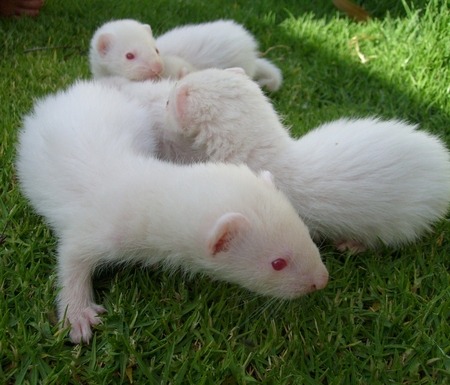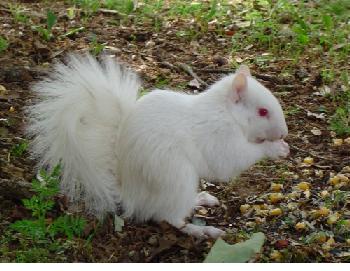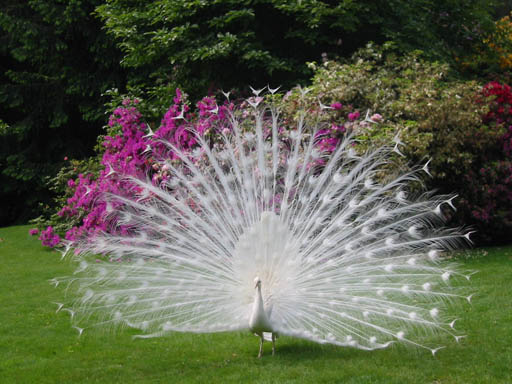|
|
|---|
Wednesday, January 19, 2011
The AKC picked three dog breeds again this year to recognize so that they could be in dog shows and do agility and stuff like that. One of these breeds was the Xolo, which I already told you about, and another one is the Norwegian Lundehund, which I am going to tell you about today.
The lundehund is a very old breed, and it comes from Norway, which you maybe already figured out from its name. The lunde part of the name is from the Norwegian word lundefugl, which means "puffin." So the lundehund is called a "puffin dog" because they were used for hunting puffins.
Puffins are these kind of funny-looking birds that like to live in the high, steep cliffs by the sea. They go there every summer and make big puffin colonies where they lay eggs and raise baby puffins. And the places where they most like to lay their eggs are in holes and narrow places in the cliffs because it's safer there. Then about the end of August, they start getting ready to leave for wherever they go during the winter, which is probably a nice spa or sunny resort in the south.
Anyway, the baby puffins haven't learned to fly yet, so the adult puffins push them -- or "puff" them -- off the edge of the mountain cliffs, which is kind of mean of them, if you ask me. And some of the baby puffins figure out how to fly, but others just kind of go splat on the rocks. And this is where the lundehunds come in, because they can climb up there and retrieve the dead puffins and maybe some live ones, too, and bring them back down to their humans.
Lundehunds are made in a special way that makes them really good at climbing the cliffs and getting the puffins. For one thing, they have extra toes on all their feet. This is called being polydactyl. So instead of just having 4 toes, like most dogs do, lundehunds have 6 toes on each foot. And the extra toes are not just floppy, dewclaw things. No, these are real toes with muscles and bones and everything they need to make them work properly.
Another thing that makes lundehunds good puffin dogs is that their joints move in all sorts of weird directions. For example, lundehunds can bend their heads back really far without even breaking their necks, and they can also stick their front legs straight out to the side, like people can do with their arms. And another thing they can do is close up their ears to keep out water and dirt and any commands that they don't want to obey.
So all of these special skills make lundehunds able to climb up the cliffs and squeeze themselves into very small spaces where the puffins are. And after they get in there, they can usually get back out again, which is also important.
Anyway, people in Norway were already using these little dogs to hunt puffins at least as long ago as 1600, and they kept using them until the 1850s, which is when people started using nets to catch puffins. Also there was a dog tax, and people didn't want to pay it. So by 1900, the only place you could really find any lundehunds was in a village called Måstad, on the island of Værøy. And the reason the people in Måstad still had dogs was because they were so out of touch that they didn't know about the new ways to hunt puffins.
Mostly the people in Måstad and other villages on the coast made their living by fishing and farming, but they also relied on puffins, especially in years when the fishing and farming weren't very good. And what they did with the puffins was they salted them and put them in barrels, and then during the winter they ate them, like in soup or whatever. Also they used the down from the puffin, because it was soft and nice, like eider down. And they could sell the down and make money that way.
But there got to be fewer and fewer lundehunds, and then a bunch of dogs died because of distemper in the 1940s and again in 1963. And after that, there were only 6 lundehunds left anywhere. One of these was on Værøy Island, and the other five, who all had the same mother, were in southern Norway. So people started breeding these lundehunds again, with a lot of rules about how to do it, and now there are probably between 1500 and 2000 lundehunds in the world. About 1100 of these are in Norway and 350 in the U.S.
Lundehunds are about the same size as basenjis, or maybe a little smaller, but they have a lot more hair. They are usually 13-15 inches tall and weigh between 12 and 20 pounds. They are smart and stubborn, which is probably because they are a primitive breed, just like basenjis! Lundehunds like to check out everything around them, and they can easily climb on stuff and go all sorts of places that maybe you don't want them to go. They also like to hide their food in secret locations, like for instance under the sofa cushion, so they can come back and eat it later.
These dogs have lots of energy, so they need lots of exercise or else they will get bored and get into trouble. They also bark a lot, and this is how they protect their home and their people. They like digging, playing with toys, and carrying things around in their mouths.
All lundehunds have the genes for a disease called "lundehund gastroenteropathy," and what this disease does is it makes you have a whole bunch of bacteria in your guts. And then with all those bacteria, it's hard to get all the good nutrient stuff out of your food. Dogs who have a really bad case of this disease can actually starve to death, even though they are eating lots of food! But not all lundehunds get sick from this disease, and even if they do, they can take pills to make them feel better.
So anyway, that's some basic information about lundehunds, and if you want to see one, there might be one at a dog show near you, or you can watch the Westminster show on TV.
The lundehund is a very old breed, and it comes from Norway, which you maybe already figured out from its name. The lunde part of the name is from the Norwegian word lundefugl, which means "puffin." So the lundehund is called a "puffin dog" because they were used for hunting puffins.
Puffins are these kind of funny-looking birds that like to live in the high, steep cliffs by the sea. They go there every summer and make big puffin colonies where they lay eggs and raise baby puffins. And the places where they most like to lay their eggs are in holes and narrow places in the cliffs because it's safer there. Then about the end of August, they start getting ready to leave for wherever they go during the winter, which is probably a nice spa or sunny resort in the south.
Anyway, the baby puffins haven't learned to fly yet, so the adult puffins push them -- or "puff" them -- off the edge of the mountain cliffs, which is kind of mean of them, if you ask me. And some of the baby puffins figure out how to fly, but others just kind of go splat on the rocks. And this is where the lundehunds come in, because they can climb up there and retrieve the dead puffins and maybe some live ones, too, and bring them back down to their humans.
Lundehunds are made in a special way that makes them really good at climbing the cliffs and getting the puffins. For one thing, they have extra toes on all their feet. This is called being polydactyl. So instead of just having 4 toes, like most dogs do, lundehunds have 6 toes on each foot. And the extra toes are not just floppy, dewclaw things. No, these are real toes with muscles and bones and everything they need to make them work properly.
Another thing that makes lundehunds good puffin dogs is that their joints move in all sorts of weird directions. For example, lundehunds can bend their heads back really far without even breaking their necks, and they can also stick their front legs straight out to the side, like people can do with their arms. And another thing they can do is close up their ears to keep out water and dirt and any commands that they don't want to obey.
So all of these special skills make lundehunds able to climb up the cliffs and squeeze themselves into very small spaces where the puffins are. And after they get in there, they can usually get back out again, which is also important.
Anyway, people in Norway were already using these little dogs to hunt puffins at least as long ago as 1600, and they kept using them until the 1850s, which is when people started using nets to catch puffins. Also there was a dog tax, and people didn't want to pay it. So by 1900, the only place you could really find any lundehunds was in a village called Måstad, on the island of Værøy. And the reason the people in Måstad still had dogs was because they were so out of touch that they didn't know about the new ways to hunt puffins.
 |
| Værøy Island |
Mostly the people in Måstad and other villages on the coast made their living by fishing and farming, but they also relied on puffins, especially in years when the fishing and farming weren't very good. And what they did with the puffins was they salted them and put them in barrels, and then during the winter they ate them, like in soup or whatever. Also they used the down from the puffin, because it was soft and nice, like eider down. And they could sell the down and make money that way.
But there got to be fewer and fewer lundehunds, and then a bunch of dogs died because of distemper in the 1940s and again in 1963. And after that, there were only 6 lundehunds left anywhere. One of these was on Værøy Island, and the other five, who all had the same mother, were in southern Norway. So people started breeding these lundehunds again, with a lot of rules about how to do it, and now there are probably between 1500 and 2000 lundehunds in the world. About 1100 of these are in Norway and 350 in the U.S.
Lundehunds are about the same size as basenjis, or maybe a little smaller, but they have a lot more hair. They are usually 13-15 inches tall and weigh between 12 and 20 pounds. They are smart and stubborn, which is probably because they are a primitive breed, just like basenjis! Lundehunds like to check out everything around them, and they can easily climb on stuff and go all sorts of places that maybe you don't want them to go. They also like to hide their food in secret locations, like for instance under the sofa cushion, so they can come back and eat it later.
These dogs have lots of energy, so they need lots of exercise or else they will get bored and get into trouble. They also bark a lot, and this is how they protect their home and their people. They like digging, playing with toys, and carrying things around in their mouths.
All lundehunds have the genes for a disease called "lundehund gastroenteropathy," and what this disease does is it makes you have a whole bunch of bacteria in your guts. And then with all those bacteria, it's hard to get all the good nutrient stuff out of your food. Dogs who have a really bad case of this disease can actually starve to death, even though they are eating lots of food! But not all lundehunds get sick from this disease, and even if they do, they can take pills to make them feel better.
So anyway, that's some basic information about lundehunds, and if you want to see one, there might be one at a dog show near you, or you can watch the Westminster show on TV.
0 Comments:
Subscribe to:
Post Comments (Atom)
























